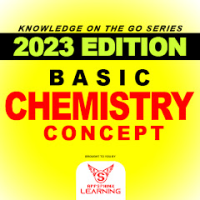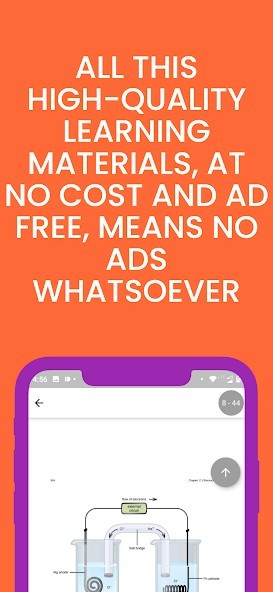
BASIC CHEMISTRY - OFFLINE
Rating: 0.00 (Votes:
0)
BASIC CHEMISTRY - KNOWLEDGE ON THE GO - NO ADS
Through this KNOWLEDGE ON THE GO series by APPSPHINX LEARNING, we bring highly sophisticated and well-organized fundamental concepts of chemistry (Courtesy OpenStax) while addressing the needs of students with diverse backgrounds and learning styles. Each topic builds upon previously developed material to demonstrate the cohesiveness and structure of chemistry.👉 AMAZING FEATURES
✔ 100% FREE
✔ NO ADS
✔ 100% OFFLINE
✔ CAREFULLY CRAFTED ALL HIGH-QUALITY CHEMISTRY MATERIAL
✔ NIGHT MODE OPTION
✔ APART FROM THE SCHOOL STUDENTS, THIS APP IS SUITABLE FOR, ENGINEERING, UPSC CSE, SSC CGL, IBPS - BANK PO, CAT, OPSC & ASO ASPIRANT WHO WANTS TO CLEAR THEIR BASIC CHEMISTRY CONCEPT.
👉DETAIL APP CONTENT
✔ 1: Essential Ideas9
1.1 Chemistry in Context
1.2 Phases and Classification of Matter
1.3 Physical and Chemical Properties
1.4 Measurements
1.5 Measurement Uncertainty, Accuracy, and Precision
1.6 Mathematical Treatment of Measurement Results
✔ 2: Atoms, Molecules, and Ions
2.1 Early Ideas in Atomic Theory
2.2 Evolution of Atomic Theory
2.3 Atomic Structure and Symbolism
2.4 Chemical Formulas
2.5 The Periodic Table
2.6 Molecular and Ionic Compounds
2.7 Chemical Nomenclature
✔ 3: Composition of Substances and Solutions
3.1 Formula Mass and the Mole Concept
3.2 Determining Empirical and Molecular Formulas
3.3 Molarity
3.4 Other Units for Solution Concentrations
✔ 4: Stoichiometry of Chemical Reactions
4.1 Writing and Balancing Chemical Equations
4.2 Classifying Chemical Reactions
4.3 Reaction Stoichiometry
4.4 Reaction Yields
4.5 Quantitative Chemical Analysis
✔ 5: Thermochemistry
5.1 Energy Basics
5.2 Calorimetry
5.3 Enthalpy
✔ 6: Electronic Structure and Periodic Properties of Elements
6.1 Electromagnetic Energy
6.2 The Bohr Model
6.3 Development of Quantum Theory
6.4 Electronic Structure of Atoms (Electron Configurations)
6.5 Periodic Variations in Element Properties
✔ 7: Chemical Bonding and Molecular Geometry
7.1 Ionic Bonding
7.2 Covalent Bonding
7.3 Lewis Symbols and Structures
7.4 Formal Charges and Resonance
7.5 Strengths of Ionic and Covalent Bonds
7.6 Molecular Structure and Polarity
✔ 8: Advanced Theories of Covalent Bonding
8.1 Valence Bond Theory
8.2 Hybrid Atomic Orbitals
8.3 Multiple Bonds
8.4 Molecular Orbital Theory
✔ 9: Gases
9.1 Gas Pressure
9.2 Relating Pressure, Volume, Amount, and Temperature: The Ideal Gas Law
9.3 Stoichiometry of Gaseous Substances, Mixtures, and Reactions
9.4 Effusion and Diffusion of Gases
9.5 The Kinetic-Molecular Theory
9.6 Non-Ideal Gas Behavior
✔ 10: Liquids and Solids
10.1 Intermolecular Forces
10.2 Properties of Liquids
10.3 Phase Transitions
10.4 Phase Diagrams
10.5 The Solid State of Matter
10.6 Lattice Structures in Crystalline Solids
✔ 11: Solutions and Colloids
11.1 The Dissolution Process
11.2 Electrolytes
11.3 Solubility
11.4 Colligative Properties
11.5 Colloids
✔ 12: Kinetics
12.1 Chemical Reaction Rates
12.2 Factors Affecting Reaction Rates
12.3 Rate Laws
12.4 Integrated Rate Laws
12.5 Collision Theory
12.6 Reaction Mechanisms
12.7 Catalysis
✔ 13: Fundamental Equilibrium Concepts
13.1 Chemical Equilibria
13.2 Equilibrium Constants
13.3 Shifting Equilibria: Le Châtelier’s Principle
13.4 Equilibrium Calculations
✔ 14: Acid-Base Equilibria
14.1 Brønsted-Lowry Acids and Bases
14.2 pH and pOH
14.3 Relative Strengths of Acids and Bases
14.4 Hydrolysis of Salts
14.5 Polyprotic Acids
14.6 Buffers
14.7 Acid-Base Titrations
✔ 15: Equilibria of Other Reaction Classes
15.1 Precipitation and Dissolution
15.2 Lewis Acids and Bases
15.3 Coupled Equilibria
✔ 16: Thermodynamics
16.1 Spontaneity
16.2 Entropy
16.3 The Second and Third Laws of Thermodynamics
16.4 Free Energy
✔ 17: Electrochemistry
17.1 Review of Redox Chemistry
17.2 Galvanic Cells
17.3 Electrode and Cell Potentials
17.4 Potential, Free Energy, and Equilibrium
17.5 Batteries and Fuel Cells
17.6 Corrosion
17.7 Electrolysis
User ReviewsAdd Comment & Review
Based on 0
Votes and 0 User Reviews
No reviews added yet.
Comments will not be approved to be posted if they are SPAM, abusive, off-topic, use profanity, contain a personal attack, or promote hate of any kind.
Tech News
Other Apps in This Category









































